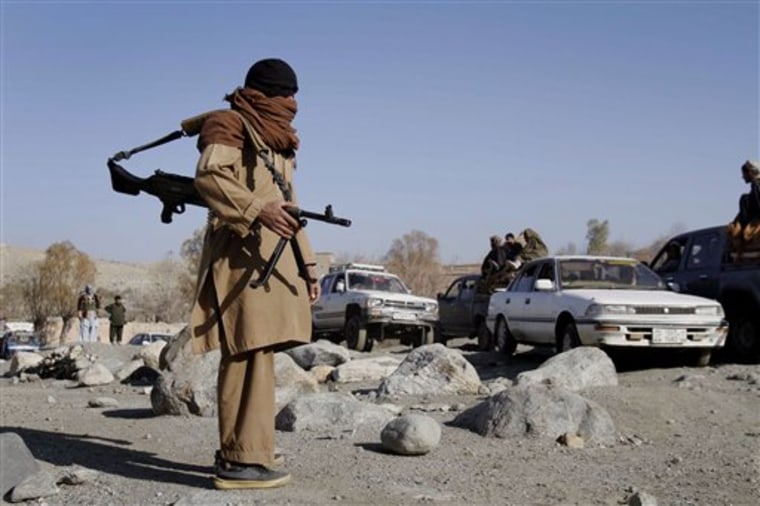The calls were threatening and they just wouldn't stop. The extortion demand was several hundred thousands of dollars.
"Or else," said the caller.
Fearful, the civil engineer started to pay. But it was never enough.
First, a rocket was fired at his home in Kapisa province in the foothills of the Hindu Kush range northeast of Kabul. Then gunmen tried to kidnap his eldest son, leaving him so badly injured that he needed treatment in India.
It wasn't necessarily the work of the Taliban. Afghanistan is also plagued by a dizzying and increasing array of armed groups, including criminal gangs, drug traffickers and freelance militias. Often with powerful backing — sometimes even potentially from police — Afghanistan's growing underclass of thugs has been terrorizing civilians across large swaths of the country, extorting money, demanding sanctuary or kidnapping for ransom.
The gangland-style muscle shows the multilayered challenges for the U.S.-led international military coalition.
In Kapisa, local officials and residents say the armed gangs prey mainly on successful businessmen who they believe can afford to cough up big sums.
The engineer, owner of a prosperous construction company, could no longer face the threats. He is fleeing Afghanistan, taking his other 10 children with him to join his injured son in India, where the 28-year-old is still under medical care more than four months after the attack. The engineer spoke on condition his name not be used because of fears of more attacks on his family or business.
"There is militia threatening at night. And also Taliban. But you don't know who belongs to who. Everyone has weapons," says Muhammad Sharif, a doctor in Maymana, the capital of the northern Faryab province, where residents say security has been deteriorating in the past few years. "It's a very confusing situation."
Aid workers have been increasingly vocal about what they say is growing uncertainty in many parts of the country.
"Armed groups and other parties to conflict seem to be proliferating," said International Committee of the Red Cross spokesman Bijan Farnoudi.
"In a growing number of areas in the country, we are entering a new, rather murky phase in the conflict in which the proliferation of armed groups threatens the ability of humanitarian organizations to reach the people who need their help," the ICRC said recently.
Some experts say one reason may be NATO's effective policy of targeting midlevel Taliban commanders. Once they are killed or captured, the area they controlled might splinter among lower-ranking fighters in charge of smaller areas. Or they might be replaced by either younger, potentially more radical commanders, or outsiders who care less about those living in the area — and don't feel accountable to them.
"There's a much weaker local Taliban command and control of the insurgency in some areas, so you'll get non-Afghans fighting ... (who) tend to be much more distant from the local population," said Kate Clark, senior analyst at the Kabul-based Afghan Analysts Network.
A top concern for many civilians is the frequent inability of police to deal with the groups. Many others — including residents, local officials and researchers — claim the armed groups often have allies inside the security forces.
One Kapisa resident — locking the door and often dropping to a whisper to discuss extortion, intimidation and kidnappings — accused local police of links to the rackets, and said those officers who are not "in these gangs are afraid of them."
The resident spoke on condition of anonymity — like nearly all local officials and residents who agreed to talk about the situation. "Yes, I am afraid," the resident said. "If they hear what I have told you, they will come to kill me."
That fear is far from unfounded.
The Afghan police and army are critical to the international community's exit strategy from Afghanistan, and are expected to take over responsibility for the country's security by 2014. But the forces, particularly the police, are widely considered corrupt and also suffer from infiltration by insurgents.
Interior Ministry spokesman Zemeri Bashary said police recruitment practices had been bolstered to prevent abuses. He rejected that police were involved in criminal gangs, although he said there were "rare cases" where police or army uniforms could have been used.
Rumours abound of people in police uniforms pressuring local businesses for "donations," being involved in kidnappings or dealing in the drug trade.
One example is Tamim Kohistani, the 25-year-old son of a former police general and former Mujaheddin fighter.
On his way home to Kabul after a visit to the northern city of Mazar-i-Sharif in late December, he and his two bodyguards were stopped at what he said looked like a legitimate police checkpoint manned by about a dozen men in full uniform just outside the town of Charikar.
He was told he was being taken to the local police station over what he thought was a document mix-up. He said he only realized he was being kidnapped when he and his bodyguards were blindfolded and bound.
The bodyguards were released with a ransom demand for Kohistani's father. Kohistani, meanwhile, spent the next day chained in an underground dungeon. He was allowed out twice to call his father. He begged for help.
"The threat was on my life. The conditions were very bad in that room. There was no air," he said.
Kohistani was released about 26 hours later. Unable to walk because the chains on his legs had been so tight, the kidnappers carried him into a car, still blindfolded, and abandoned him by the side of a road.
He is still not sure whether the men at the checkpoint were police or just using the uniforms.
But one top official in Kapisa says he has strong suspicions.
"Eighty percent I think they were real police," the official said, speaking on condition his name not be used for fear of reprisals. "Fifty or 60 percent of police are corrupt" in the region.
___
Associated Press writer Amir Shah contributed to this report.
